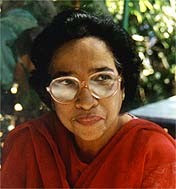

.
A visit to Wittenberg was a pilgrimage long overdue. The town has been immortalized by Martin Luther, the monk who rebelled against the Catholic Church in the 16th century, for selling indulgences to gullible people, as a sacrament of penance. His act of nailing his 95 theses to the door of the Castle Church in Wittenberg was the beginning of the Protestant Reformation in Germany.
The entire town pays tribute to its hero through its churches, statues, Theological colleges and various other landmarks. But what struck me when I entered the Luther House where he lived and worked for many years, was the imposing sculpture of Katherine von Bora, a woman who defied tradition and shocked the Christian world of the 16th century with her daring-do. Few applauded her courage. Most thought she was a schemer. Her enemies were many, and friends just a handful. But she proved herself a worthy mistress of the Black Cloister, the house given to Martin Luther by the Elector John, as his permanent residence.
Katherine lost her mother at an early age. Her father, who married again, abdicated his parental responsibilities and admitted her into a Benedictine Convent in Brehna as a boarder. Later, at the age of ten, she was inducted into the convent at Nimbschen for her vocation as a nun. She received a good education, but physical labour and limited quantities of food were part of convent discipline. The child in her must have rebelled against such a difficult and Spartan lifestyle. It was also a cloistered existence with hardly any scope for mingling with the public.
By then, Martin Luther’s Reformation was gaining ground. Based on his deep study of the Bible, he refuted many of the restrictions of the Catholic Church. He realized that sexuality was God’s gift to mankind and was an inseparable part of human nature. Therefore priests should be allowed to marry if they so desired.
Luther’s revolutionary statements made their way through the hitherto impenetrable portals of Katherine’s convent. It incited Katherine and eight other fugitive nuns to flee the convent. They hid themselves in the wagon of a wholesaler Leonard Kopp, who brought goods regularly to the institution. Hidden behind his large fish barrels, they fled to Wittenberg, hoping that the great reformer would take care of their future. They were completely without means or plans, but with a ring leader like Katherine, they were sure that things wouldn’t go wrong.
Luther felt responsible for their resettlement. Some were given in marriage to his friends. Others went back to their parental homes. But Katherine remained, as no one would take her for a wife. She lived as a domestic help in the house of Lucas Cranach the painter.
Luther had no intention of marrying Katherine. He thought she was proud and arrogant. But in the end, because of her growing restlessness and lack of other suitors, he was persuaded to take her as his wife. Critics hollered that Martin had started the Reformation merely to satisfy his sexual needs. Katherine the runaway nun had married her pimp Luther after living in sin for over a year, they said. They predicted that the anti-Christ would be born from the union of a sex-starved nun and a degenerate monk. But these rumours were disproved when the couple had six normal children.
There was nothing passionate about their union. He was forty one and she was twenty six years old. Katherine craved for respectability through marriage to a famous man. The thought of presiding over his home excited her. Practical and down to earth, her management skills overrode Luther’s other-worldliness. His monetary status couldn’t put bread on the table for his family. But when Katherine took over, she initiated many money making schemes such as rearing domestic animals for food and milk, planting kitchen gardens for vegetable and fruit, and providing meals for students of theology.
Luther House is now a museum where one can visit the rooms where he worked and lived. His extensive library of books and manuscripts, photographs, paintings and personal belongings are on all display here.
Katherine’s yearning to possess land and property became an obsession. Though there was much criticism, she had the patronage of the Elector. Most of her economic endeavours were done without Luther’s knowledge. Theirs was not an intellectual partnership, and she had no influence whatsoever over his sermons and writings. But Luther did admire her skills in money management, and always took her side against adverse criticism.
“In domestic duties I defer to Kate,” he said, “Otherwise I am led by the Holy Spirit.”
Katherine was ugly with a long nose and stubborn chin, but she had intelligence and personality. Some biographers describe her as a “quick witted Saxon with a ready tongue.”
After Luther’s death, Katherine lived on at the Black Cloister with her children. But in 1546, when Saxony was in a state of war, she fled to Madgeburg for a while. She lost a lot of her money and property. She returned to Wittenberg in 1548, until the Black Plague threatened the area. Now she fled to Torgau with her family. But her carriage met with an accident, and she suffered injuries. She also suffered a chill from which she never recovered. She died on December 20th, 1552, and was buried at the Church of St. Mary in Torgau.
The marriage of the runaway nun and the rebel monk created history and brought about Luther’s break with monasticism and clericalism. Katherine provided him with the means and the privacy to pursue his writing, teaching and preaching activities.
Katherine loved being wealthy and in total control of her fiefdom the Black Cloister. She was a woman who could shake off animosity and criticism with a decisive shrug of her broad shoulders.


















